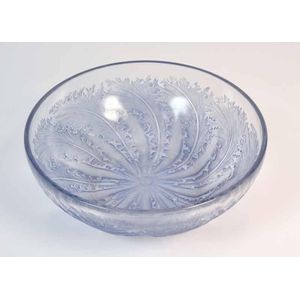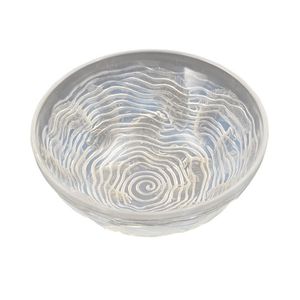Rene Lalique 'Dauphines' Fish Bowl
You must be a subscriber, and be logged in to view price and dealer details.
Subscribe Now to view actual auction price for this item
When you subscribe, you have the option of setting the currency in which to display prices to $Au, $US, $NZ or Stg.
- Etched - Glass decorated with an etched design, which is achieved through marking out the pattern, protecting the area that is not be etched, and then immersing the object in acid to dissolve the surface of the unprotected area. With some glass objects, such as cameo glass, there may be several layers of different coloured glass, and part of the top layer is dissolved leaving the bottom layer as the background. The longer the time of exposure of the object to acid, the deeper the etching.
The word etching is also sometimes used to describe another method of decoration, where wheel grinders were used decorate the surface, but this technique is usually known as engraving. - Opalescent / Opaline - The descriptions of glass as "opalescent" or "opaline" are often used interchangeably by dealers and auction houses. At the upper end of the scale, opalescent / opaline glass can refer to the opal-like milky blue glass produced by Lalique and Etling. It also refers to the pressed glass mass produced in Britain from the 1840s with a milky white edge as sugar-basins, milk jugs and vases were made in great quantities for the mass market, and were sold at fairs along with Staffordshire figures and wooden dolls. A less common type of opalescent glass was made from two layers of glass blown into a mould.
- Acid Etched - Acid etching is often used on glass, metals, and stone to create decorative finishes or to prepare the surface for further treatment or coating. The process of acid etching involves applying an acidic solution, such as hydrochloric acid or nitric acid, to the surface of the material and allowing it to react with the surface. The acid etches away a thin layer of the material, creating a rough, uneven finish. Acid etching can be used to create a variety of different finishes, from a subtle matte finish to a more pronounced, textured finish.
This item has been included into following indexes:
Visually similar items

Chinese porcelain saucer dish, decorated in the Kangxi manner of kraak style panels, the underside bearing a six character Guangxu reign mark. No obvious faults. Diameter 13 cm

A fine Yaozhou ware small tea bowl, Song Dynasty (960-1279), 12th century, combed and incised with three fishes amongst waves, fitted box, 5.2 cm high 11.1 cm diameter

An Art Deco R. Lalique 'Chicoree' bowl. First designed around 1921. Clear and frosted glass with blue patina, moulded 'R. Lalique France' and engraved 'No 3213'. Marcilhac number 3213. Diameter 24 cm

A Chinese blue and white charger 19th century crack to foot, 37 cm diameter
